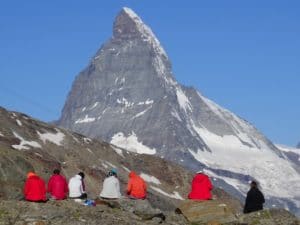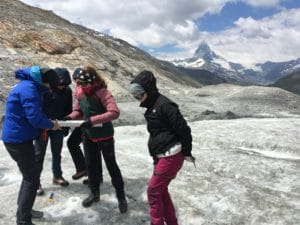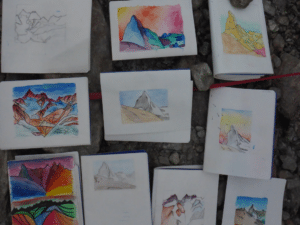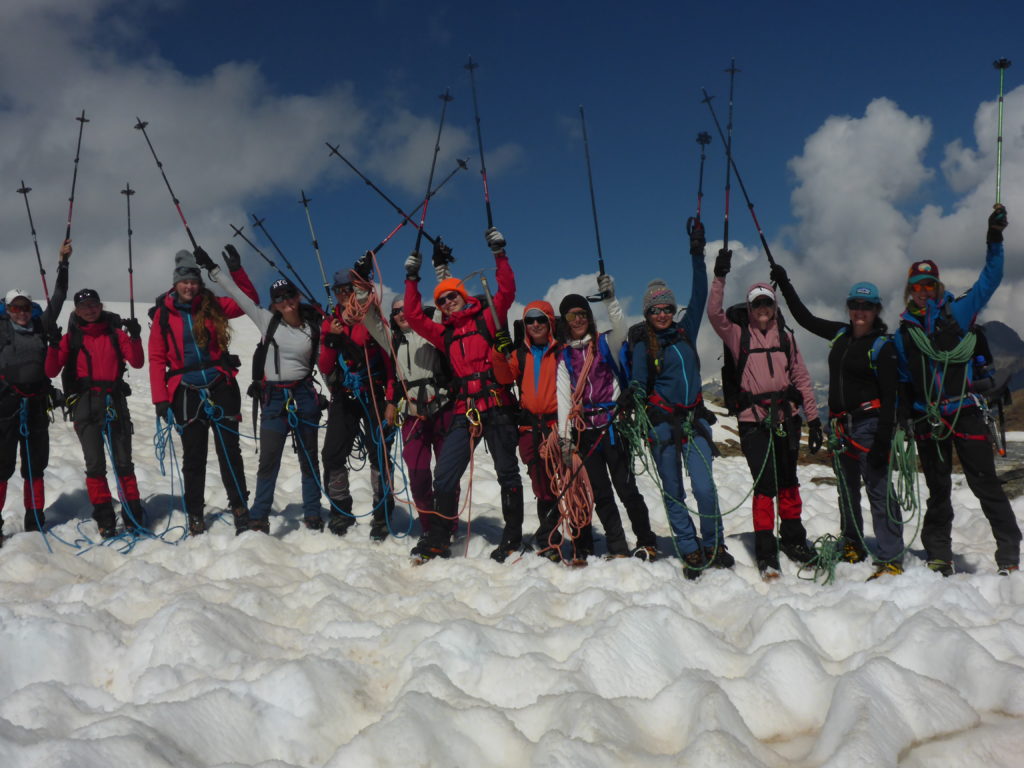
Expedition participants sit looking towards the Matterhorn near Zermatt in Switzerland. Image: Lena Hellmann/Girls on Ice Switzerland.
Written by Lena Hellmann, Geographer and Leader of Girls on Ice Switzerland.
In Switzerland, only 25 out of approximately 1,500 mountain guides are female, in Germany this number is around 10 out of approximately 500. Scientific positions, particularly in the natural sciences, are dominated by men with with only 23 percent of all university professors in Switzerland (1) and in Germany (2) being women. Even though these numbers have been increasing over recent decades, Girls on Ice Switzerland aims to further change these gender biases. As part of the international organisation Inspiring Girls Expeditions, the mission of Girls on Ice Switzerland is to bring out teenage girls’ natural curiosity, to inspire their interest in science, and to connect arts and sciences. The exclusively female-guided mountain expedition encourages girls aged 15-17 to trust in their physical and intellectual abilities.
During a week-long expedition, participants camp in a high-alpine glacial environment far away from supermarkets, shopping centres, or cinemas, and without a mobile phone. All necessary food and equipment is carried up to the campsite in backpacks, with the help of some female volunteers. Each meal is prepared on gas stoves, water is taken out of the nearby creek and filtered before drinking, and participants share a tent with two other girls they have never met before. These are only few examples that demonstrate the importance of participants taking care of themselves and each other, respecting the needs of others, communicating their own needs, and building confidence.
“It was incredible how fast we became friends during the week. This was the biggest surprise for me – even though we really had to work a lot together,” said one participant after the 2018 expedition. Another thought, “this week changed me personally in regard to team-building, working together, taking care, and respecting other people.” The girls are responsible for one task every day, such as serving as a journalist, artist, cook, safety leader, etc. Of these roles, the team leader is the most challenging, described as “really a little bit strange” by one girl, who afterwards commented that she “actually felt quite well with this role.”
 Participants working on their science research project. Image: Lena Hellmann/Girls on Ice Switzerland.
Participants working on their science research project. Image: Lena Hellmann/Girls on Ice Switzerland.
In groups of three, the girls create and realize a small research project during the week, which they present in front of a public audience at the end of the programme. Planning the experiment with restricted time, material, measuring biases, or limited data, plus interpretation of the data and the presentation of the results allows participants to directly experience the ups and downs of scientific work. And this obviously changes the impression the girls have of scientists and their work: “Often scientists are represented as ´nerds` who have nothing but science on their minds. But actually they are just people who are really interested in a specific topic. But who still have some free time and are not ´freaks´ – in plain language!” said one girl of what she had learned from the programme. Another admitted that she knew that “one needs a lot of creativity to be a scientist” and that “one has to think a lot” but that she did not expect “that one has to be so extraordinarily creative.”
A new and very stimulating experience for the majority of the girls, and also for the instructors, are the programme’s art activities. Exercises on how to observe and draw a landscape – on contours, details, and sketching – changes the perception of art, and often the attitude towards it. The utility of art to transmit scientific messages and the similarities of art and science when it comes to observations are often astonishing. And the art pieces that result from some of the drawing exercises are very impressive!
 Some examples of the artwork created by participants during the expedition. Image: Lena Hellmann/Girls on Ice Switzerland
Some examples of the artwork created by participants during the expedition. Image: Lena Hellmann/Girls on Ice Switzerland
The Findelen glacier provides the perfect environment for learning and practicing mountaineering skills such as walking with crampons, in a roped party, or using an ice axe. Often the girls doubt their physical abilities before the expedition: “I asked myself several times if I am fit enough, in particular because I have never been on a similar expedition.” But usually they come down from the glacier with a different impression, saying for example “yes, I think I became more self-confident” or “in the beginning I was daunted by the programme, but in the end everything worked out and after all everything went well.”
In the end, when all the girls arrive at the camp after climbing the more than 3000m nearby peak, the tension they might have felt before the camp is completely gone and replaced by happiness and more self-confidence.
For more information about Girls on Ice Switzerland, please visit the website.
1. Frauen- und Ausländeranteil bei Professoren an Universitäten in der Schweiz von 2011 bis 2013 und Prognose* bis 2023. Source: Statista
2. Frauenanteil in Professorenschaft 2015 auf 23 % gestiegen. Source: Statistischen Bundesamtes (Germany)


